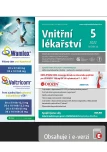Time in range: new parameter to evaluate blood glucose control
Authors:
MUDr. Milan Flekač, Ph.D.
Authors‘ workplace:
3. interní klinika VFN a 1. LF UK v Praze
Published in:
Vnitř Lék 2022; 68(5): 315-323
Category:
Review Articles
doi:
https://doi.org/10.36290/vnl.2022.066
Overview
Continuous glucose monitoring became more common in everyday clinical practice. New parameters have been created as a standard for assessing the degree of control for people with diabetes and can be used more clearly than glycated haemoglobin. The new parameter time in range represents a significant benefit not only for diabetologists, but also an important tool to help the patients in their daily lives with diabetes.
Keywords:
continuous glucose monitoring – target values – time in range – glucose profile analysis – diabetes control
Sources
1. American Diabetes Association. 7. Diabetes technology: Standards of Medical Care in Diabetes 2019. Diabetes Care. 2019;42(Suppl.1):S71-S80.
2. Nathan DM, Genuth S, Lachin J et al. Diabetes Control and Complications Trial Research Group. The effect of intensive treatment of diabetes on the development and progression of long‑term complications in insulin‑dependent diabetes mellitus. N Engl J Med. 1993;329:977–986.
3. UK Prospective Diabetes Study (UKPDS) Group. Intensive blood‑glucose control with sulphonylureas or insulin compared with conventional treatment and risk of complications in patients with type 2 diabetes (UKPDS 33). Lancet. 1998;352:837-853.
4. Holman RR, Paul SK, Bethel MA, Matthews DR, Neil HAW. 10-year follow‑up of intensive glucose control in type 2 diabetes. N Engl J Med. 2008;359:1577-1589.
5. Beck RW, Connor CG, Mullen DM et al. The fallacy of average: how using HbA1c alone to assess glycemic control can be misleading. Diabetes Care. 2017;40:994-999.
6. Rodbard D. Glucose variability: a review of clinical applications and research developments. Diabetes technology & therapeutics. 2018 Jun 1;20(S2):S2-5.
7. National Institute of Diabetes and Digestive and Kidney Diseases Health Information Center. Sickle cell trait & other hemoglobinopathies & diabetes (for providers) [Internet]. Available from https://www.niddk.nih.gov/health‑information/ diagnostic‑tests/sickle‑cell‑trait‑hemoglobinopathies in diabetes. Accessed 12 January 201838. Bry L, Chen PC, Sacks DB. Effects of hemoglobin variants and chemically modified derivatives on assays for glycohemoglobin. Clin Chem. 2001;47:153-163.
8. Ford ES, Cowie CC, Li C, Handelsman Y et al. Iron‑deficiency anemia, non iron‑deficiency anemia and HbA1c among adults in the US. J Diabetes. 2011;3:67-73.
9. Nielsen LR, Ekbom P, Damm P et al. HbA1c levels are significantly lower in early and late pregnancy. Diabetes Care. 2004;27:1200-1201.
10. Petrie JR, Peters AL, Bergenstal RM et al. Improving the clinical value and utility of CGM Systems: issues and recommendations: a joint statement of the European Association for the Study of Diabetes and the American Diabetes Association Diabetes Technology Working Group. Diabetes Care. 2017;40:1614-1621.
11. Battelino T, Danne T, Bergenstal RM et al. Clinical Targets for Continuous Glucose Monitoring Data Interpretation: Recommendations From the International Consensus on Time in Range. Diabetes Care. 2019 Aug;42(8):1593-1603.
12. Vigersky RA, McMahon C. The Relationship of Hemoglobin A1C to Time‑in‑Range in Patients with Diabetes. Diabetes Technol Ther. 2019 Feb;21(2):81-85.
13. Bergenstal RM, Beck RW, Close KL et al. Glucose Management Indicator (GMI): A New Term for Estimating A1C From Continuous Glucose Monitoring. Diabetes Care. 2018 Nov;41(11):2275-2280.
14. Beck RW, Bergenstal RM, Riddlesworth TD, et al. Validation of Time in Range as an Outcome Measure for Diabetes Clinical Trials. Diabetes Care. 2019 Mar;42(3):400-405.
15. Polonsky WH, Hessler D. What are the quality of life‑related benefits and losses associated with real‑time continuous glucose monitoring? A survey of current users. Diabetes Technol Ther. 2013 Apr;15(4):295-301.
16. El Malahi A, Van Elsen M, Charleer S et al. Relationship Between Time in Range, Glycemic Variability, HbA1c, and Complications in Adults With Type 1 Diabetes Mellitus. J Clin Endocrinol Metab. 2022 Jan 18;107(2):e570-e581.
17. Lu J, Ma X, Zhou J et al. Association of Time in Range, as Assessed by Continuous Glucose Monitoring, With Diabetic Retinopathy in Type 2 Diabetes. Diabetes Care. 2018 Nov;41(11):2370-2376.
18. Johnson ML, Martens TW, Criego AB, Carlson AL, Simonson GD, Bergenstal RM. Utilizing the Ambulatory Glucose Profile to Standardize and Implement Continuous Glucose Monitoring in Clinical Practice. Diabetes Technol Ther. 2019 Jun;21(S2):S217-S225.
19. Riddlesworth TD, Beck RW, Gal RL et al. Optimal Sampling Duration for Continuous Glucose Monitoring to Determine Long‑Term Glycemic Control. Diabetes Technol Ther. 2018 Apr;20(4):314-316.
20. Goldenberg RM, Aroda VR, Billings LK et al. Effect of insulin degludec versus insulin glargine U100 on time in range: SWITCH PRO, a crossover study of basal insulin‑treated adults with type 2 diabetes and risk factors for hypoglycaemia. Diabetes Obes Metab. 2021 Nov;23(11):2572-2581.
21. Danne T, Axel Schweitzer M, Keuthage W et al. Impact of Fast‑Acting Insulin Aspart on Glycemic Control in Patients with Type 1 Diabetes Using Intermittent‑Scanning Continuous Glucose Monitoring Within a Real‑World Setting: The GoBolus Study. Diabetes Technol Ther. 2021 Mar;23(3):203-212.
Labels
Diabetology Endocrinology Internal medicineArticle was published in
Internal Medicine

2022 Issue 5
Most read in this issue
- Differential diagnosis of back pain
- Early diagnosis of systemic scleroderma
- What is new in the treatment of Systemic Lupus Erythematosus?
- What’s new in 2021 ESC Guidelines on cardiovascular disease prevention in clinical practice?
